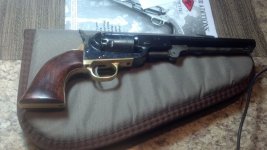This revolver was purchased new, two months ago, from Cabela's and has been a work in progress since that day. Many modifications have been made. The original Pietta backstrap and wood grips were tossed aside and replaced with a custom brass backstrap and hand made wood grips that are much closer to something of proper Colt geometry. The flimsy and fragile Pietta hand spring system has been replaced with a Ruger spring and plunger, the moving internal components have been deburred and polished, the cylinder exits have been deburred/crowned, rear sight opened up for windage and better target viewing... and the stock Pietta nipples have been replaced with "Slix-Shot" nipples. The wood grips were carved from Rosewood burl and finished with Tung oil. As much fun as this revolver was to shoot, last weekend, I'm a bit sad that the 'smithy' work is now over. Cabela's has a sale on their Uberti 1847 Walkers. A set of Rosewood burl grips would look great on one of those, plus. I also have an idea as to how I can keep the loading lever from dropping, when firing the revolver, while also making it look good. No leather straps, or rubber bands required! Anyone have any suggestions as to how I can best convince the Mrs. that my going to Cabela's and coming home with another BP revolver would be in the best interest of us both? Probably not. I never came up with a convincing argument when I was buying fishing poles. Why should it work with guns?
Attachments
Last edited:

